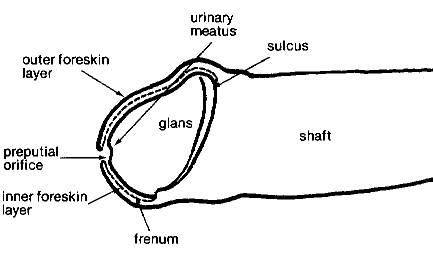Guidelines for Parents
American Academy of Pediatrics
At birth, the penis consists of a cylindrical shaft with a rounded end called the glans. The shaft and glans are separated by a groove called the sulcus. The entire penis - shaft and glans - is covered by a continuous layer of skin. The section of the penile skin that covers the glans is called the foreskin or prepuce. The foreskin consists of two layers, the outer foreskin and an inner lining similar to a mucous membrane.
Before birth, the foreskin and glans develop as one tissue. The foreskin is firmly attached - really fused - to the glans. Over time, this fusion of the inner surface of the prepuce with the glans skin begins to separate by shedding the cells from the surface of each layer. Epithelial layers of the glans and the inner foreskin lining are regularly replaced, not only in infancy but throughout life. The discarded cells accumulate as whitish, cheesy ``pearls'' which gradually work their way out via the tip of the foreskin.
Eventually, sometimes as long as 5, 10, or more years after birth, full separation occurs and the foreskin may then be pushed back away from the glans toward the abdomen. This is called foreskin retraction. The foreskin may retract spontaneously with erections which occur normally from birth on and even occur in fetal life. Also, all children ``discover'' their genitals as they become more aware of their bodies and may retract the foreskin themselves. If the foreskin does not seem to retract easily early in life, it is important to realize that this is not abnormal and that it should eventually do so.

Drawing reprinted with permission of Edward Wallerstein, author of Circumcision: An American Health Fallacy.
![]() Note:
Note:
[The Function of the Foreskin: The glans at birth is delicate and easily irritated by urine and feces. The foreskin shields the glans; with circumcision this protection is lost. In such cases, the glans and especially the urinary opening (meatus) may become irritated or infected, causing ulcers, meatitis (inflammation of the meatus), and meatal stenosis (a narrowing of the urinary opening). Such problems virtually never occur in uncircumcised penises. The foreskin protects the glans throughout life.]
![]() Note:
Note:
Infant Smegma: Skin cells from the glans of the penis and the inner foreskin are shed throughout life. This is especially true in childhood; natural skin shedding serves to separate the foreskin from the glans. Since this shedding takes place in a relatively closed space - with the foreskin covering the glans - the shed skin cells cannot escape in the usual manner. They escape by working their way to the tip of the foreskin. These escaping discarded skin cells constitute infant smegma, which may appear as white ``pearls'' under the skin.
Adult Smegma: Specialized sebaceous glands - Tyson's Glands - which are located on the glans under the foreskin, are largely inactive in childhood. At puberty, Tyson's Glands produce an oily substance, which, when mixed with shed skin cells, constitute adult smegma. Adult smegma serves a protective, lubricating function for the glans.
Foreskin Hygiene: The foreskin is easy to care for. The infant should be bathed or sponged frequently, and all parts should be washed including the genitals. The uncircumcised penis is easy to keep clean. No special care is required! No attempt should be made to forcibly retract the foreskin. No manipulation is necessary. There is no need for special cleansing with Q-tips, irrigation, or antiseptics; soap and water externally will suffice.
Foreskin Retraction: As noted, the foreskin and glans develop as one tissue. Separation will evolve over time. It should not be forced. When will separation occur? Each child is different. Separation may occur before birth; this is rare. It may take a few days, weeks, months, or even years. This is normal. Although many foreskins will retract by age 5, there is no need for concern even after a longer period. [1984 version only: No harm will come in leaving the foreskin alone.] Some boys do not attain full retractability of the foreskin until adolescence.
Hygiene of the Fully Retracted Foreskin: For the first few years, an occasional retraction with cleansing beneath is sufficient.
Penile hygiene will later become a part of a child's total body hygiene, including hair shampooing, cleansing the folds of the ear, and brushing teeth. At puberty, the male should be taught the importance of retracting the foreskin and cleaning beneath during his daily bath.
Summary: Care of the uncircumcised boy is quite easy. ``Leave it alone'' is good advice. External washing and rinsing on a daily basis is all that is required. Do not retract the foreskin in an infant, as it is almost always attached to the glans. Forcing the foreskin back may harm the penis, causing pain, bleeding, and possibly adhesions. The natural separation of the foreskin from the glans may take many years. After puberty, the adult male learns to retract the foreskin and cleanse under it on a daily basis.
The Circumcision Information and Resource Pages are a not-for-profit educational resource and library. IntactiWiki hosts this website but is not responsible for the content of this site. CIRP makes documents available without charge, for informational purposes only. The contents of this site are not intended to replace the professional medical or legal advice of a licensed practitioner.
© CIRP.org 1996-2025 | Filetree | Please visit our sponsor and host:
IntactiWiki.